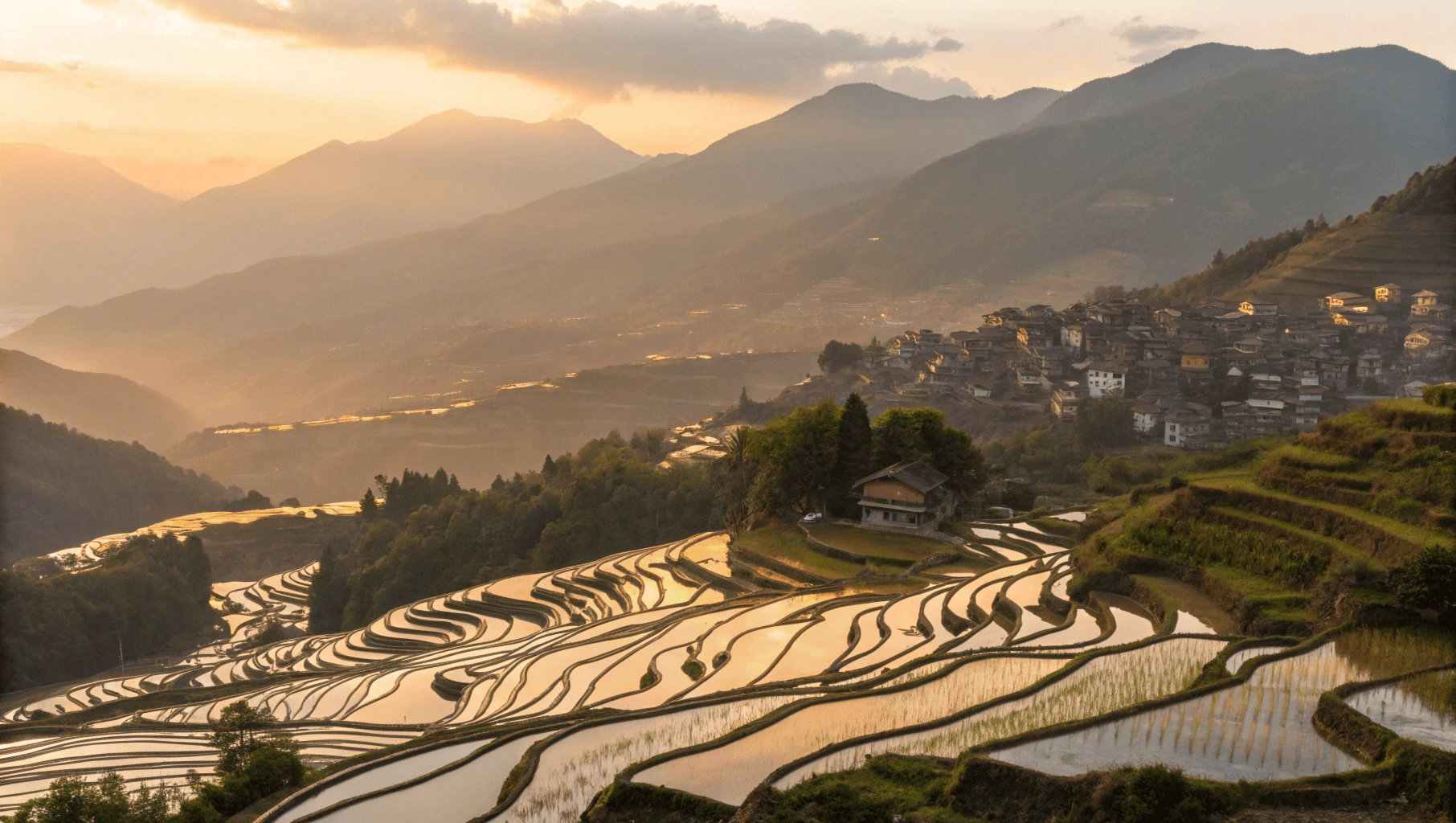Last updated: May 2025
Nestled in China’s southwestern corner, Yunnan province remains one of the country’s most captivating yet underappreciated destinations. As an avid traveler who’s explored Yunnan extensively over the past decade, I’m excited to share this comprehensive guide to help you plan an unforgettable journey through this remarkable region.
Whether you’re drawn to dramatic mountain landscapes, ancient cultural traditions, or extraordinary culinary experiences, yunnan china travel offers a kaleidoscope of adventures that rival any destination in Asia. This guide combines practical planning information with insider tips to help you navigate this diverse province with confidence.
Table of Contents
Why Visit Yunnan?

Yunnan stands apart from other Chinese provinces in several meaningful ways that make it particularly rewarding for travelers:
Unparalleled Cultural Diversity
Home to 25 of China’s 56 recognized ethnic groups, yunnan china travel offers cultural experiences you simply won’t find elsewhere. Unlike more homogenized eastern regions, here you’ll encounter distinctive architecture, traditional dress, music, and customs that have persisted for centuries.
During my visit to a Naxi village near Lijiang, I participated in a traditional “Dongba” ceremony where ancient pictographic scripts—one of the world’s last living hieroglyphic writing systems—are still used by shamanic priests. These authentic cultural experiences happen regularly throughout the province.
Dramatic Geographic Contrasts
Within a single province, yunnan china travel encompasses:
- Snow-capped Himalayan peaks in the north
- Subtropical jungles in the south
- The dramatic gorges of the Mekong and Yangtze Rivers
- Some of Asia’s most productive agricultural valleys
This geographic diversity means you can trek through alpine meadows in the morning and explore tropical botanical gardens by afternoon.
Biodiversity Hotspot
Yunnan contains over 50% of China’s plant and animal species despite occupying just 4% of the country’s land area. The province is home to:
- Over 17,000 plant species
- More than 1,800 bird species
- Endangered wildlife including black-crested gibbons, Asian elephants, and yunnan china travel golden monkeys
For nature enthusiasts, each region offers distinct ecosystems to explore.
Culinary Paradise
Yunnan’s cuisine reflects its diversity with distinctive regional specialties influenced by neighboring countries and indigenous traditions. From the mushroom markets of Kunming to the Tibetan yak butter tea of Shangri-La, eating your way across Yunnan is an adventure in itself.
Authentic Travel Experiences
Despite growing tourism, many parts of Yunnan remain refreshingly authentic. Traditional agricultural practices continue, markets buzz with local commerce (not just tourist trinkets), and genuine cultural exchange is still possible, especially if you venture beyond the main tourist hubs.
Yunnan Quick Facts & Overview
| Geography | Southwestern China, bordering Vietnam, Laos, and Myanmar |
|---|---|
| Size | 394,000 km² (slightly larger than Japan) |
| Population | Approximately 48 million |
| Capital | Kunming (6.7 million people) |
| Major Regions | Northern Highlands (Shangri-La), Central Plateaus (Kunming, Dali), Southern Lowlands (Xishuangbanna) |
| Languages | Mandarin Chinese (official), plus numerous minority languages including Bai, Naxi, Tibetan dialects |
| Currency | Chinese Yuan (CNY/¥) |
| Time Zone | China Standard Time (GMT+8) |
| Electricity | 220V, 50Hz (Type A, C and I plugs) |
| Climate | Varies dramatically by region and elevation: subtropical in the south, temperate in central areas, alpine in the north |
Key Regions of Yunnan
Northern Yunnan
- Shangri-La (Diqing Prefecture): Tibetan culture, alpine landscapes, meadows and monasteries
- Lijiang: UNESCO Old Town, Naxi culture, gateway to Tiger Leaping Gorge
- Dali: Bai minority culture, relaxed atmosphere, Erhai Lake
Central Yunnan
- Kunming: Provincial capital, mild climate, Stone Forest
- Jianshui: Well-preserved traditional architecture and Confucian temple
- Yuanyang: Spectacular rice terraces, Hani minority villages
Southern Yunnan
- Xishuangbanna: Tropical climate, Dai culture with Thai influences, tea plantations
- Pu’er: Famous for its tea, subtropical forests
- Jinghong: Gateway to the region, Mekong River, night markets
Best Time to Visit Yunnan
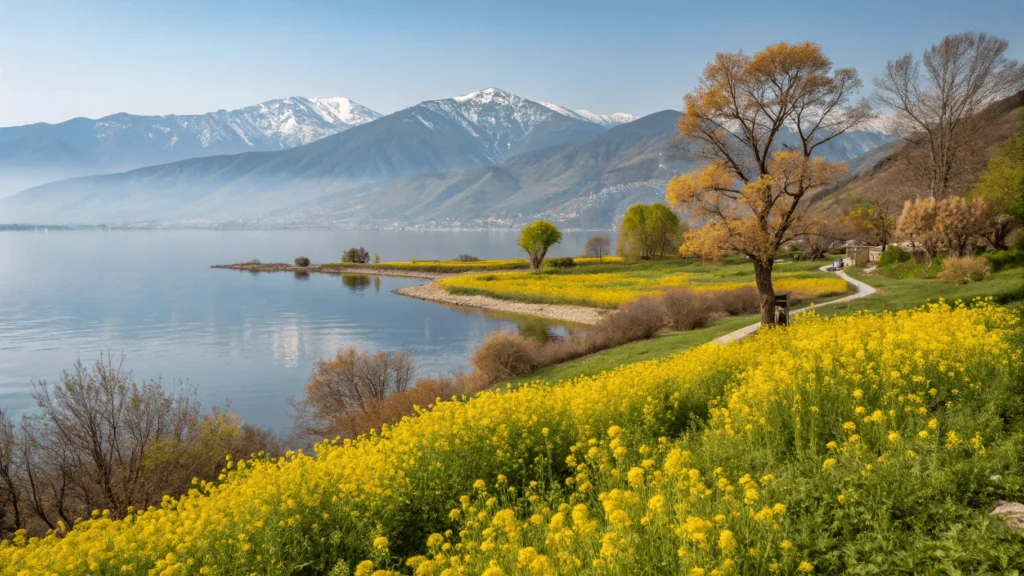
Due to Yunnan’s varied elevations and microclimates, the ideal travel time depends on which regions you plan to visit. Here’s a comprehensive month-by-month breakdown:
January-February
- Northern Yunnan: Cold (-5°C to 10°C), snow at higher elevations, fewer tourists
- Central Yunnan: Cool (5°C to 15°C), generally dry
- Southern Yunnan: Pleasant (15°C to 25°C), ideal time to visit the tropical south
- Festivals: Chinese New Year (dates vary), Torch Festival in some ethnic regions
March-April
- Northern Yunnan: Warming up (0°C to 15°C), spring blooms beginning
- Central Yunnan: Comfortable (10°C to 20°C), azaleas and camellias in bloom
- Southern Yunnan: Warming (18°C to 28°C), becoming hot
- Festivals: Water Splashing Festival (mid-April)
May-June
- Northern Yunnan: Pleasant (10°C to 20°C), alpine flowers emerging
- Central Yunnan: Warm (15°C to 25°C), occasional rain showers
- Southern Yunnan: Hot and increasingly humid (25°C to 35°C)
- Festivals: Dali Raosanling (May/June), Dragon Boat Festival (dates vary)
July-August
- Northern Yunnan: Warm days (15°C to 25°C), mild nights, alpine wildflowers
- Central Yunnan: Rainy season (16°C to 24°C), lush green landscapes
- Southern Yunnan: Hot and humid (25°C to 35°C), frequent afternoon downpours
- Considerations: Peak domestic tourism season, higher prices, some hiking trails may be slippery
September-October
- Northern Yunnan: Cooling (5°C to 20°C), clear skies, brilliant autumn colors
- Central Yunnan: Pleasant (15°C to 25°C), harvest time
- Southern Yunnan: Warm (20°C to 30°C), decreasing rainfall
- Overall: Often considered the ideal time to visit yunnan china travel as a whole
November-December
- Northern Yunnan: Cold (0°C to 15°C), clear days, potential snow at higher elevations
- Central Yunnan: Cool (5°C to 15°C), dry season begins
- Southern Yunnan: Pleasant (15°C to 25°C), optimal weather
- Considerations: Lower tourism numbers, good deals on accommodation
Pro Tip: If you’re planning to explore multiple regions of Yunnan, September to October or April to May generally offer the best overall weather conditions. During my October visit, I enjoyed clear skies for photography and comfortable temperatures for hiking throughout the province.
Getting To Yunnan
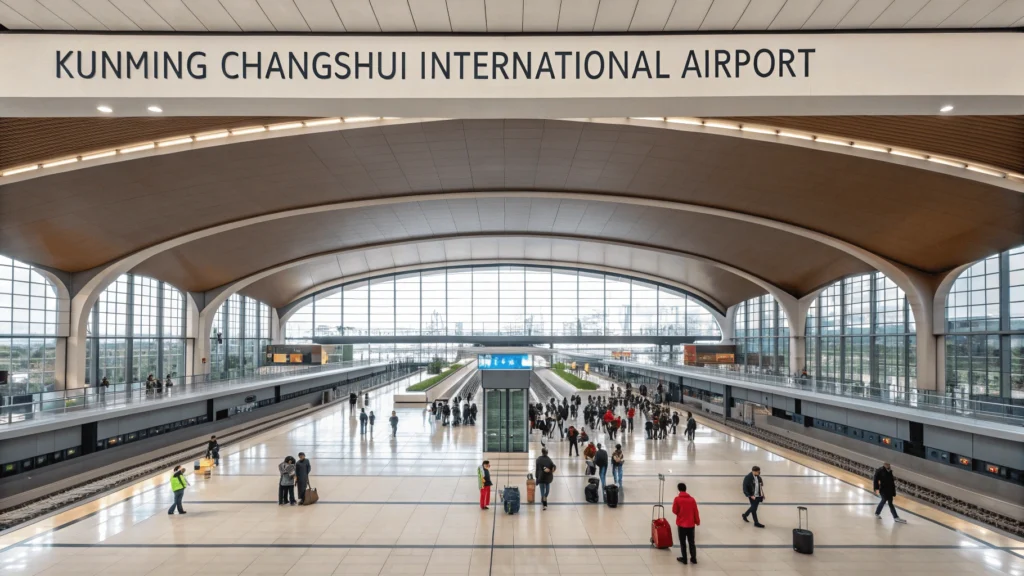
International Flights
Kunming Changshui International Airport (KMG) serves as the main gateway to Yunnan and has expanded its international connections significantly:
Direct international routes to Kunming:
- Southeast Asia: Bangkok, Singapore, Kuala Lumpur, Hanoi, Seoul
- East Asia: Tokyo, Seoul, Taipei
- Middle East: Dubai (connecting to Europe and North America)
Most travelers from Europe, North America, and Australia will need to connect through major Asian hubs like Bangkok, Singapore, Hong Kong, or Shanghai.
Booking Tips:
- Look for connecting flights through major Asian hubs rather than direct routes from Western countries
- Consider flying into China via Beijing, Shanghai, or Guangzhou and then connecting to Kunming
- Book 3-4 months in advance for the best fares
Domestic Routes to Yunnan
If you’re already in China, reaching Yunnan is straightforward:
Flights:
- Direct flights connect Kunming to all major Chinese cities
- Secondary yunnan china travel airports in Lijiang, Dali, Shangri-La, and Jinghong also have connections to major Chinese cities
- Flying time from Shanghai or Beijing to Kunming: approximately 3-4 hours
High-Speed Trains:
- Kunming is connected to China’s high-speed rail network
- Beijing to Kunming: approximately 11 hours
- Shanghai to Kunming: approximately 11-12 hours
- Guangzhou to Kunming: approximately 8 hours
Conventional Trains:
- More affordable but significantly slower
- Sleeper cabins available for overnight journeys
- Beijing to Kunming: approximately 36-40 hours
Buses:
- Connect Yunnan to neighboring provinces
- Generally not recommended for long-distance travel from eastern China due to time required
Border Crossings: If coming from Southeast Asia, land border crossings are possible from:
- Vietnam (Hekou-Lao Cai crossing)
- Laos (Mohan-Boten crossing)
- Myanmar (Ruili-Muse crossing)
Note that border crossing regulations and availability may change; always check current requirements before planning a land border crossing.
Getting Around Yunnan
Yunnan’s varied terrain presents unique transportation challenges. Here’s a comprehensive breakdown of your options:
High-Speed Trains
Network: Yunnan’s high-speed rail network has expanded significantly, now connecting:
- Kunming to Dali (2 hours)
- Kunming to Lijiang (3 hours)
- Kunming to Shangri-La (planned for late 2025)
Pros:
- Fast, comfortable, and punctual
- Beautiful views along many routes
- Affordable (Kunming-Dali: ¥120-180)
- No need to deal with traffic
Cons:
- Limited to major destinations
- May require additional transportation to reach your final destination
- Need to book in advance during peak periods
Booking Tips:
- Use Trip.com (English interface) or the official China Railway website (Chinese only)
- Book 1-2 weeks in advance for peak seasons
- Second class seats are comfortable and cost 30-40% less than first class
Regular Trains
Network: More extensive than high-speed rail, reaching smaller cities and towns
Pros:
- More economical than high-speed trains
- Reach destinations not serviced by high-speed rail
- Overnight sleeper trains save on accommodation costs
Cons:
- Significantly slower (Kunming to Dali: 6-8 hours vs. 2 hours on high-speed)
- Variable comfort levels
- Less frequent departures
Classes:
- Hard seat (basic, not recommended for long journeys)
- Soft seat (more comfortable, similar to second class on regular trains)
- Hard sleeper (open compartment with 6 berths)
- Soft sleeper (compartment with 4 berths, more privacy)
Buses
Network: The most comprehensive transportation network, reaching virtually every town and village
Types:
- Express buses (高速客车) between major cities
- Regular buses to smaller towns
- Minibuses for local routes
Pros:
- Reach destinations not serviced by trains
- Frequent departures
- No need to book far in advance
- Economical (Kunming-Dali: ¥120-160)
Cons:
- Mountain roads can be winding and sometimes uncomfortable
- Varying safety standards
- Language barriers at smaller stations
- Longer travel times than trains for equivalent distances
Tips:
- For mountain routes, take motion sickness medication if you’re prone to it
- Use official bus stations rather than informal minibus services for longer routes
- Ask your accommodation to write your destination in Chinese characters
Private Drivers
Availability: Easily arranged through hotels, guesthouses, or travel agencies
Costs:
- Day rates: ¥600-1,200 depending on distance and vehicle type
- Multi-day excursions: ¥700-1,500 per day including driver’s accommodation
Pros:
- Maximum flexibility
- Stop wherever and whenever you want
- Reach remote areas efficiently
- Local driver knowledge
- No language issues once arranged
Cons:
- More expensive than public transportation
- Variable driver English proficiency
- Need to negotiate rates and itinerary
Tips:
- Agree on price, itinerary, and stops in advance
- Confirm whether entrance fees and driver’s meals are included
- Check if your driver has local knowledge of the specific area
Domestic Flights
Network: yunnan china travel has multiple airports including:
- Kunming (KMG) – Main hub
- Lijiang (LJG)
- Dali (DLU)
- Shangri-La/Diqing (DIG)
- Jinghong (JHG)
- Tengchong (TCZ)
Pros:
- Save significant time on longer distances
- Reasonable prices (Kunming-Lijiang: ¥350-700)
- Avoid challenging mountain roads
Cons:
- Weather disruptions in mountainous areas
- Environmental impact
- Need to arrive early for security
Airlines serving Yunnan:
- China Eastern
- China Southern
- Lucky Air (based in Kunming)
- Ruili Airlines
- Spring Airlines (budget carrier)
Transportation Recommendation by Region
| Journey | Recommended Transport | Approximate Time | Approximate Cost |
|---|---|---|---|
| Kunming to Dali | High-speed train | 2 hours | ¥120-180 |
| Dali to Lijiang | Express bus or private driver | 3-4 hours | ¥60-80 (bus) |
| Lijiang to Tiger Leaping Gorge | Minibus or private driver | 2 hours | ¥40-60 (bus) |
| Lijiang to Shangri-La | Express bus | 4 hours | ¥90-120 |
| Kunming to Yuanyang | Express bus | 7-8 hours | ¥150-180 |
| Kunming to Jinghong | Flight | 1 hour | ¥400-800 |
Personal Experience: During my most recent trip, I combined high-speed rail between major cities with a private driver for exploring rural areas around Dali and Lijiang. This provided the perfect balance of efficiency and flexibility, allowing impromptu stops at villages and viewpoints that weren’t on any standard itinerary.
Top Destinations in Yunnan
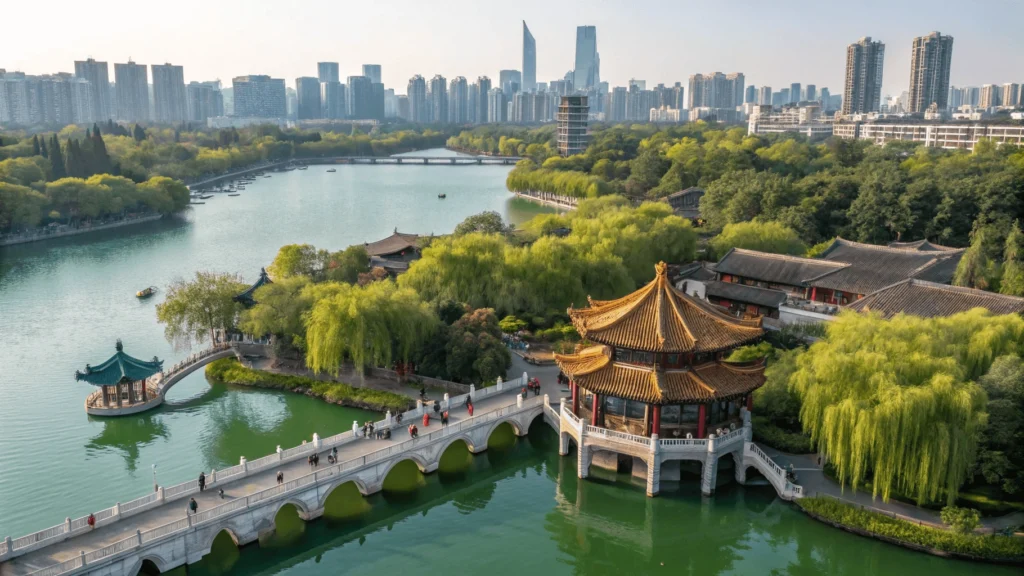
Kunming: The Spring City
Why Visit: As Yunnan’s capital and transportation hub, Kunming offers a pleasant introduction to the province with its year-round mild climate and blend of modern amenities and cultural attractions.
Don’t Miss:
- Stone Forest (Shilin) – A vast karst landscape of limestone formations resembling petrified trees, located 86km from the city. Allocate at least half a day and hire a local guide to navigate beyond the crowded main area.
- Green Lake Park (Cuihu) – The city’s central park where locals practice tai chi, dance, and music. In winter (November to March), thousands of seagulls migrate here from Siberia.
- yunnan china travel Provincial Museum – Excellent introduction to the province’s diverse cultures and history.
- Bird and Flower Market – Browse everything from handicrafts to cultural artifacts in this atmospheric market.
- Western Hills and Dragon Gate – A scenic area with Buddhist grottos carved into cliffs offering panoramic views of Dian Lake.
Where to Stay:
- Luxury: Grand Park Kunming (¥700-1,000/night)
- Mid-range: Lost Garden Guesthouse (¥300-500/night)
- Budget: The Hump Hostel (¥60-150/night)
Getting Around: Kunming has an efficient subway system connecting major attractions, with Line 3 reaching the train station. Taxis are affordable and plentiful.
Time Needed: 2-3 days
Dali: Between Mountains and Lake
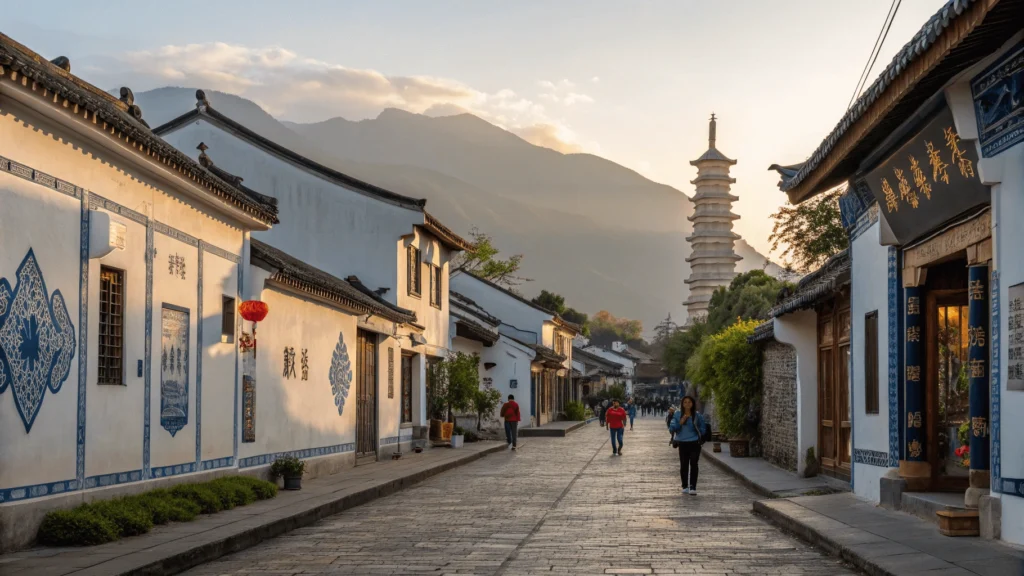
Why Visit: Set between the Cangshan Mountains and Erhai Lake, Dali combines natural beauty with the distinctive architecture and traditions of the Bai minority.
Don’t Miss:
- Dali Ancient Town – Beautifully preserved with characteristic Bai architecture, cobblestone streets, and city walls.
- Three Pagodas of Chongsheng Temple – Dating back over 1,000 years, these pagodas survived numerous earthquakes and symbolize Dali.
- Erhai Lake – Cycle around parts of the shoreline, explore fishing villages, or take a boat cruise. Sunrise here is particularly magical.
- Xizhou Town – A less touristy Bai village 20km north of Dali with authentic architecture and daily markets.
- Cangshan Mountains – Hike well-marked trails or take the cable car for spectacular views over Dali and the lake.
Where to Stay:
- Luxury: The Linden Centre in Xizhou (¥1,200-1,800/night)
- Mid-range: Landscape Hotel in Dali Old Town (¥400-600/night)
- Budget: Jade Emu International Guesthouse (¥100-200/night)
Getting Around: Electric golf carts within the old town, taxis for longer distances, and bicycle rentals for exploring the lake shore.
Time Needed: 2-4 days
Local Experience: Instead of the touristy boat tours from Caicun, I arranged a private boat with a local fisherman from a small village on the east side of Erhai Lake. He demonstrated traditional cormorant fishing methods and brought me to small islands not visited by larger tours.
Lijiang: UNESCO Heritage and Naxi Culture
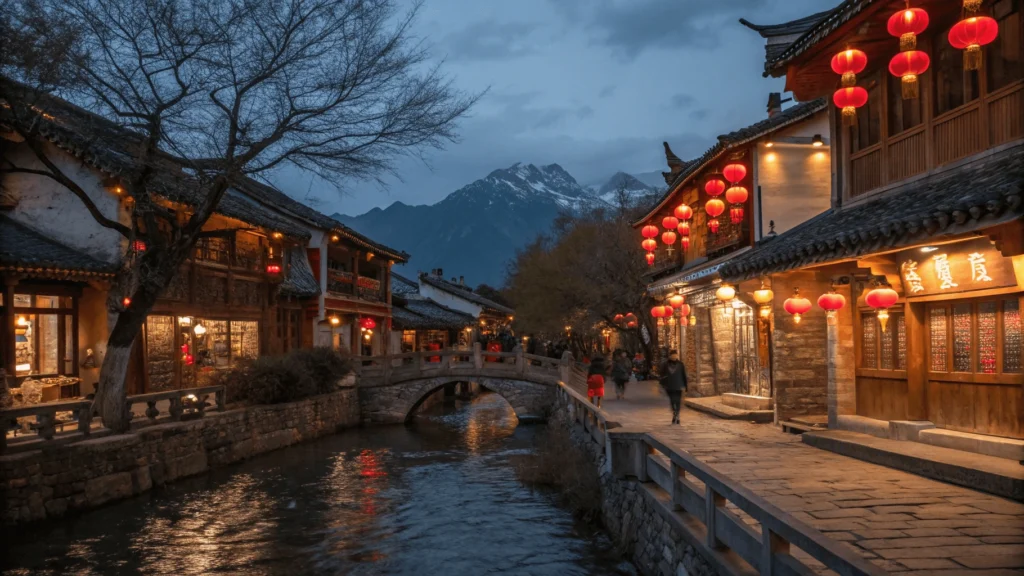
Why Visit: Famous for its UNESCO-listed old town with intricate water canals, bridges, and well-preserved traditional Naxi architecture.
Don’t Miss:
- Lijiang Old Town – Best explored early morning or evening when day-trippers have departed. Get lost in the maze of lanes away from the main shopping streets.
- Black Dragon Pool – Park offering iconic views of Jade Dragon Snow Mountain reflected in the clear waters.
- Jade Dragon Snow Mountain – Take the cable car to the spectacular glacier park at 4,500m elevation. Start early and bring warm clothing regardless of season.
- Baisha Village – Former capital of the Naxi kingdom with remarkable Ming Dynasty frescoes blending Han, Tibetan, and Naxi artistic styles.
- Shuhe Ancient Town – A more relaxed alternative to Lijiang Old Town, with similar architecture but fewer crowds.
Where to Stay:
- Luxury: Amandayan (¥2,500-4,000/night)
- Mid-range: Zen Garden Hotel (¥600-900/night)
- Budget: October Inn (¥150-300/night)
Getting Around: Lijiang Old Town is pedestrian-only. Taxis and minibuses connect to surrounding attractions.
Time Needed: 3-4 days including trips to surrounding areas
Altitude Notes: Lijiang sits at 2,400m elevation. Most visitors acclimatize easily, but take it slow on your first day if arriving directly from lower elevations.
Shangri-La (Zhongdian): Tibetan Borderlands
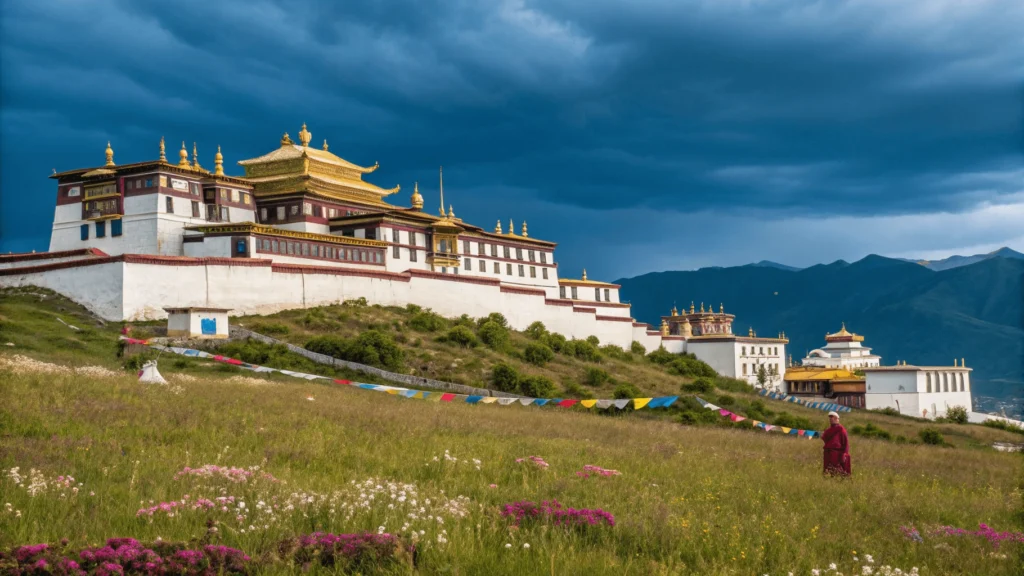
Why Visit: Renamed after James Hilton’s fictional paradise, Shangri-La offers an accessible taste of Tibetan culture, architecture, and alpine landscapes.
Don’t Miss:
- Ganden Sumtseling Monastery – The largest Tibetan Buddhist monastery in Yunnan, often compared to Lhasa’s Potala Palace on a smaller scale.
- Dukezong Old Town – Despite a fire in 2014 that destroyed parts of it, the rebuilt areas and surviving sections maintain Tibetan architectural styles.
- Pudacuo National Park – China’s first national park encompassing stunning Shudu and Bita Lakes, alpine meadows, and forests. The boardwalk trails make exploration easy.
- Napa Hai Lake – A seasonal wetland and lake where thousands of migratory birds arrive in winter. Local Tibetan villages surround the lake.
- Balagezong – A less-visited scenic area with dramatic gorges, unusual rock formations, and traditional villages.
Where to Stay:
- Luxury: Songtsam Retreat (¥1,800-2,500/night)
- Mid-range: Arro Khampa Boutique Hotel (¥600-900/night)
- Budget: Kevin’s Trekker Inn (¥150-250/night)
Getting Around: Old town is walkable; taxis and tour vehicles for outlying attractions.
Time Needed: 2-3 days
Altitude Consideration: At 3,200m elevation, altitude sickness is a real concern. Schedule a relaxed first day, stay hydrated, avoid alcohol, and consider arriving from Lijiang rather than directly from lower elevations.
Tiger Leaping Gorge: China’s Epic Trek
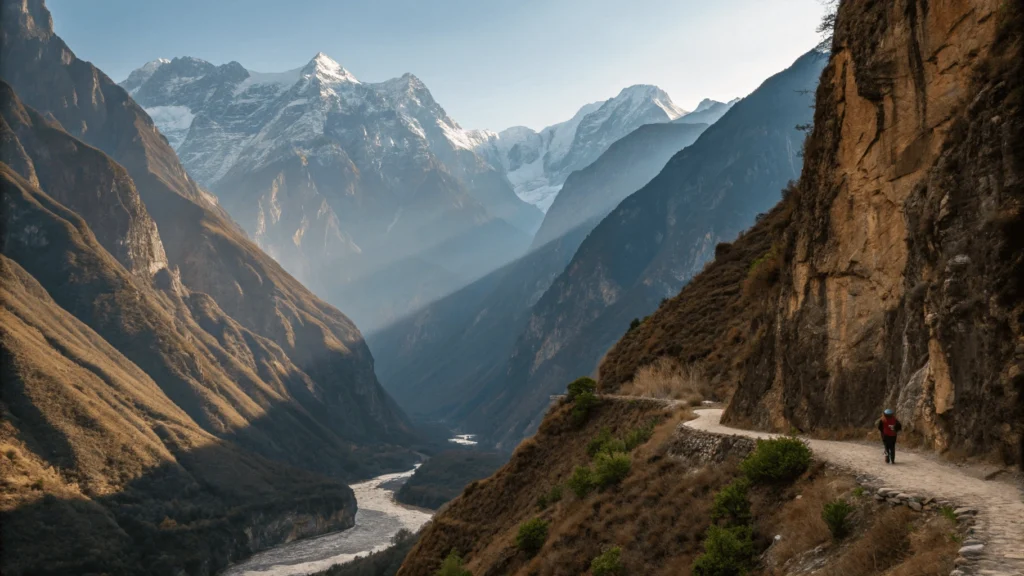
Why Visit: One of the world’s deepest gorges offers China’s most renowned trek with spectacular scenery as the Yangtze River squeezes between 3,500m cliffs.
Don’t Miss:
- The High Trail – The main 2-day hiking route along the northern side of the gorge with guesthouses along the way.
- 28 Bends – The most challenging uphill section offering incredible views as reward.
- Middle Tiger Leaping Stone – Access point to the river where, according to legend, a tiger escaped hunters by leaping across the narrowest point.
- Tea Horse Guesthouse Views – Perhaps the most spectacular overnight view in all of China.
Hiking Options:
- Full High Trail (recommended): 22km, typically hiked over 2 days with an overnight stay
- One-day partial hike: To the halfway point and back
- Lower Road: Paved road following the river (less impressive but no significant climbing)
Where to Stay:
- Naxi Family Guesthouse – Simple but comfortable rooms with excellent food (¥60-100/night)
- Halfway Guesthouse – Popular overnight point with stunning views (¥80-150/night)
- Tea Horse Guesthouse – Perhaps the best views along the trail (¥100-180/night)
Getting There: Minibuses run from Lijiang to Qiaotou (the trail starting point). Private drivers can be arranged through Lijiang guesthouses.
Time Needed: 2-3 days
Personal Experience: Rather than rushing through in one day or the standard two days, I spent three days on the trail, giving me time to explore side paths and spend extra time photographing the stunning landscape. The Naxi Family Guesthouse cooked one of the best meals of my entire China trip.
Yuanyang Rice Terraces: Living Agricultural Art
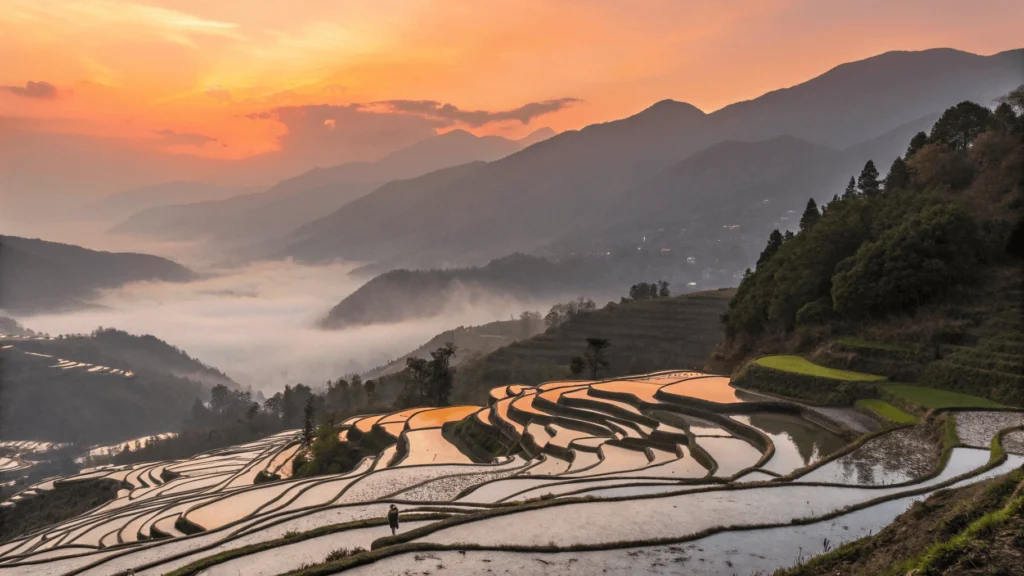
Why Visit: Among the world’s most spectacular agricultural landscapes, these rice terraces have been cultivated by the Hani people for over 1,300 years.
Don’t Miss:
- Duoyishu – The premier sunrise viewing point as light gradually illuminates the terraces.
- Bada – Excellent for mid-day photography when terraces are filled with water.
- Laohuzui (Tiger’s Mouth) – Considered the most dramatic viewpoint, ideal for sunset.
- Qingkou Hani Village – Traditional settlement showcasing Hani architecture and lifestyle.
- Local Markets – Rotating markets where different ethnic groups come to trade (ask locally for the schedule).
Best Timing:
- Water-filled terraces: November to April, with February-March offering the most reliable mirror-like reflections
- Green rice shoots: May to July
- Golden harvest: September to October
Where to Stay:
- Mid-range: Yunti Hotel in Shengcun (¥400-600/night)
- Budget: Jacky’s Guesthouse in Duoyishu (¥150-250/night)
Getting There: Express buses run from Kunming to Xinjie (county town) taking 7-8 hours. From Xinjie, local transportation reaches the various viewing areas.
Time Needed: 2-3 days minimum
Photography Tips: Sunrise and sunset create the most dramatic lighting. Weather changes rapidly, so plan for multiple mornings/evenings at key viewpoints. A tripod is essential for low-light photography. Wide-angle lenses capture the grand scale, while telephotos isolate interesting patterns.
Shaxi: Ancient Tea Horse Road Trading Post
Why Visit: Largely overlooked until recently, Shaxi represents one of the best-preserved horse caravan towns along the ancient Tea Horse Road trading route between yunnan china travel and Tibet.
Don’t Miss:
- Sideng Market Square – Beautifully restored central plaza and theater
- Xingjiao Temple – Contains rare Song Dynasty frescoes blending Buddhist and local imagery
- Friday Market – Weekly market where Yi and Bai minorities from surrounding villages come to trade
- Shibaoshan Mountain – Ancient Buddhist grottoes and temples in the hills above Shaxi
- Mapingguan Village – Traditional settlement with minimal tourism development
Where to Stay:
- Mid-range: Old Theatre Inn (¥450-700/night)
- Budget: Horse Pen 46 (¥120-220/night)
Getting There: Buses connect from both Dali (2.5 hours) and Lijiang (2 hours).
Time Needed: 1-2 days
Local Experience: I stayed with a Bai family who invited me to help prepare their traditional three-course tea ceremony, where different tea styles represent bitterness, sweetness, and aftertaste—a metaphor for the stages of life.
Popular Yunnan Itineraries
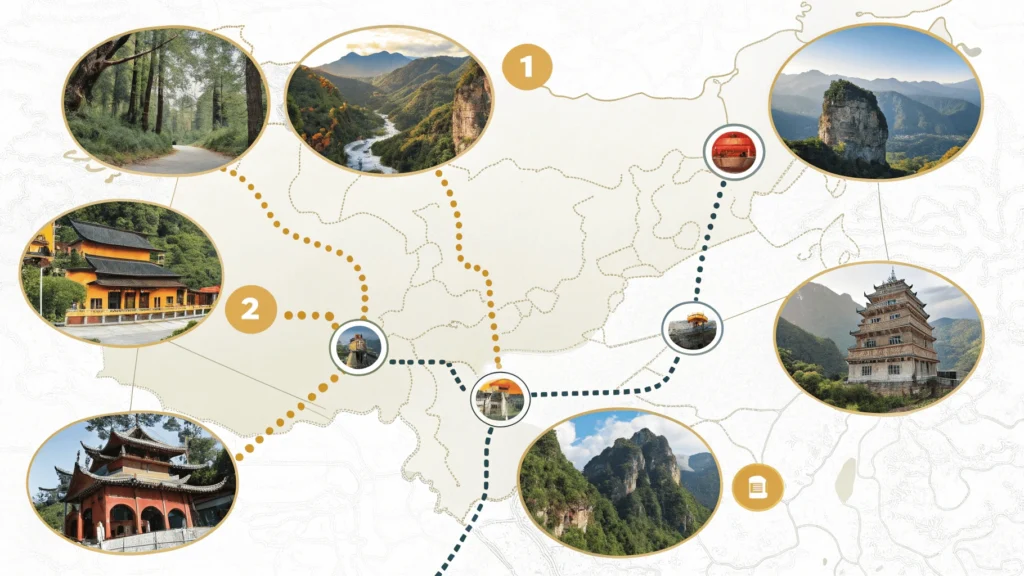
Classic 1-Week Loop
Perfect for: First-time visitors wanting to see Yunnan’s highlights
Day 1: Arrive in Kunming
- Stone Forest (half-day excursion)
- Green Lake Park
- Overnight in Kunming
Day 2: Travel to Dali (morning train)
- Explore Dali Old Town
- Three Pagodas
- Overnight in Dali
Day 3: Dali
- Morning at Erhai Lake
- Afternoon in Xizhou Village
- Overnight in Dali
Day 4: Travel to Lijiang (morning bus)
- Explore Lijiang Old Town
- Black Dragon Pool
- Overnight in Lijiang
Day 5: Lijiang Area
- Day trip to Jade Dragon Snow Mountain
- Evening in Shuhe Ancient Town
- Overnight in Lijiang
Day 6: Travel to Tiger Leaping Gorge
- Hike to Halfway House Guesthouse
- Overnight at gorge guesthouse
Day 7: Complete Tiger Leaping Gorge hike
- Return to Lijiang
- Fly out (or return to Kunming)
Comprehensive 2-Week Journey
Perfect for: Travelers wanting a deeper yunnan china travel experience
Days 1-2: Kunming
- Stone Forest
- Provincial Museum
- Western Hills
- Bird & Flower Market
Days 3-4: Yuanyang Rice Terraces
- Sunrise at Duoyishu
- Sunset at Laohuzui
- Local market
- Hani village visit
Days 5-7: Dali & surroundings
- Dali Old Town
- Cangshan hiking
- Erhai Lake cycling
- Xizhou and Zhoucheng villages
Day 8: Shaxi
- Ancient town exploration
- Shibaoshan grottoes
Days 9-11: Lijiang & surroundings
- Lijiang Old Town
- Baisha village
- Jade Dragon Snow Mountain
- Shuhe Ancient Town
Days 12-13: Tiger Leaping Gorge
- Complete 2-day trek
Days 14-15: Shangri-La
- Sumtseling Monastery
- Pudacuo National Park
- Dukezong Old Town
Off-the-Beaten-Path 10-Day Adventure
Perfect for: Return visitors or those seeking less touristy experiences
Days 1-2: Kunming to Jianshui
- Zhu Family Garden
- Tuanshan Village
- Swallow Cave
- Twin Dragon Bridge
Days 3-4: Yuanyang Rice Terraces
- Focus on lesser-known viewpoints
- Homestay in a Hani village
Days 5-6: Xishuangbanna
- Wild Elephant Valley
- Traditional Dai villages
- Tea plantations
- Tropical botanical garden
Days 7-8: Tengchong
- Heshun Ancient Town
- Hot springs
- Volcanoes Geological Park
Days 9-10: Nujiang Valley
- Visit Lisu and Nu minority villages
- Dramatic gorge scenery
- Return to Kunming
Budget Backpacking Route (2 Weeks)
Perfect for: Budget travelers using public transportation
Days 1-2: Kunming
- Budget hostels in the city center
- Free attractions like Green Lake Park
- Local food markets
Days 3-5: Dali
- Budget guesthouses in Dali Old Town
- Self-guided hiking in Cangshan
- Local bus to Xizhou
Days 6-7: Lijiang
- Hostels outside the old town for better rates
- Free exploration of old town and surroundings
Days 8-9: Tiger Leaping Gorge
- Complete the trek staying in basic guesthouses
Days 10-12: Shangri-La
- Budget guesthouses near Dukezong
- Free monastery visits (outside of ticketed areas)
- Walking tours
Days 13-14: Return to Kunming via overnight train
- Final city exploration
Approximate Budget:
- Accommodation: ¥80-150/night
- Food: ¥50-100/day
- Transportation: ¥50-100/day
- Entrance Fees: ¥500-800 total
Money-Saving Tips:
- Travel during shoulder season (April-May, September-October)
- Use shared minibuses between destinations
- Eat at local small restaurants rather than tourist establishments
- Consider an overnight train journey to save on accommodation
Top Things to Do in Yunnan
Hiking & Outdoor Adventures
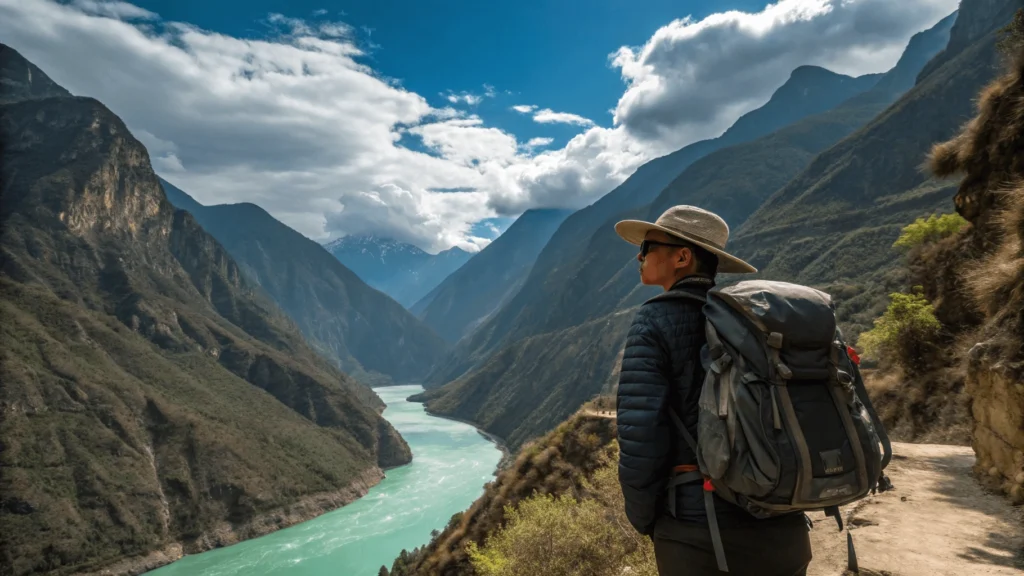
- Tiger Leaping Gorge Trek – China’s most famous hike with dramatic canyon views
- Jade Dragon Snow Mountain – Alpine meadows and glacier views up to 4,500m elevation
- Cangshan Mountains – Well-marked trails with views of Dali and Erhai Lake
- Pudacuo National Park – Easy boardwalk trails around alpine lakes
- Laojunshan National Park – Challenging multi-day hikes through remote mountains
- Meili Snow Mountain – Trekking near sacred peaks on the Tibet border
- Cycling Around Erhai Lake – 120km flat route passing fishing villages and temples
Cultural Experiences
- Attend a Tea Ceremony – Learn about Yunnan’s tea traditions, particularly Pu’er tea
- Visit Local Markets – Experience authentic rural life at weekly rotating markets
- Learn Traditional Handicrafts – Try tie-dye in Zhoucheng, papermaking in Lijiang, or pottery in Jianshui
- Dongba Cultural Museum – Understand the unique Naxi pictographic writing system
- Tibetan Monastery Visits – Experience morning chanting sessions at monasteries in Shangri-La
- Village Homestays – Stay with minority families in traditional houses
- Naxi Orchestra Performance – Listen to ancient Taoist music preserved for generations in Lijiang
Food Adventures
- Kunming Street Food Tour – Sample dishes like crossing-the-bridge noodles and wild mushroom hotpot
- Cooking Classes – Learn to prepare yunnan china travel specialties from local chefs
- Mushroom Foraging – Join guided expeditions during summer months
- Local Brewery Tours – Sample craft beers made with local ingredients in Dali and Lijiang
- Tea Plantation Tours – Visit Pu’er or Xishuangbanna tea mountains to see production
- Farmers’ Markets – Experience the incredible diversity of local produce and prepared foods
Photography Hotspots
- Yuanyang Rice Terraces – Sunrise and sunset create incredible light on these ancient agricultural marvels
- Dongchuan Red Land – Colorful terraced fields with striking red soil contrasting against green crops
- Erhai Lake – Misty mornings with traditional fishing boats and mountain backdrops
- Pudacuo National Park – Alpine lakes reflecting snow-capped mountains
- Ancient Towns – Atmospheric alleyways, traditional architecture, and local life in Lijiang, Dali, and Shaxi
- Ethnic Minority Villages – Colorful traditional dress, festivals, and daily life
- Meili Snow Mountain – Sacred peaks catching alpenglow at sunrise
Markets & Shopping
- Kunming Bird and Flower Market – Browse everything from traditional crafts to antiques
- Dali Foreigner Street – Local handicrafts with Bai minority characteristics
- Lijiang Old Town – Silver jewelry, Naxi embroidery, and woodcarvings
- Zhoucheng Village – Center of Bai tie-dye production using traditional techniques
- Xizhou Morning Market – Local produce and food items with minimal tourist trinkets
- Friday Market in Shaxi – Authentic rural trading experience with minimal tourism influence
- Jinghong Night Market – Tropical fruits and Dai minority specialties
Relaxation
- Tengchong Hot Springs – Natural volcanic hot springs with varying temperatures
- Lakeside Stays in Dali – Boutique guesthouses with views over Erhai Lake
- Tea Houses – Traditional spaces for sipping tea and watching local life unfold
- Spa Treatments – Traditional Chinese massage and herbal treatments
- Meditation Retreats – Buddhist-influenced programs in temples and mountain settings
- Boutique Eco-Resorts – Luxury experiences in natural settings, particularly in Xishuangbanna
Yunnan Food Guide
Yunnan’s cuisine is among China’s most diverse, influenced by its many ethnic groups and neighboring countries. Here are essential dishes and dining experiences to seek out:
Must-Try Dishes
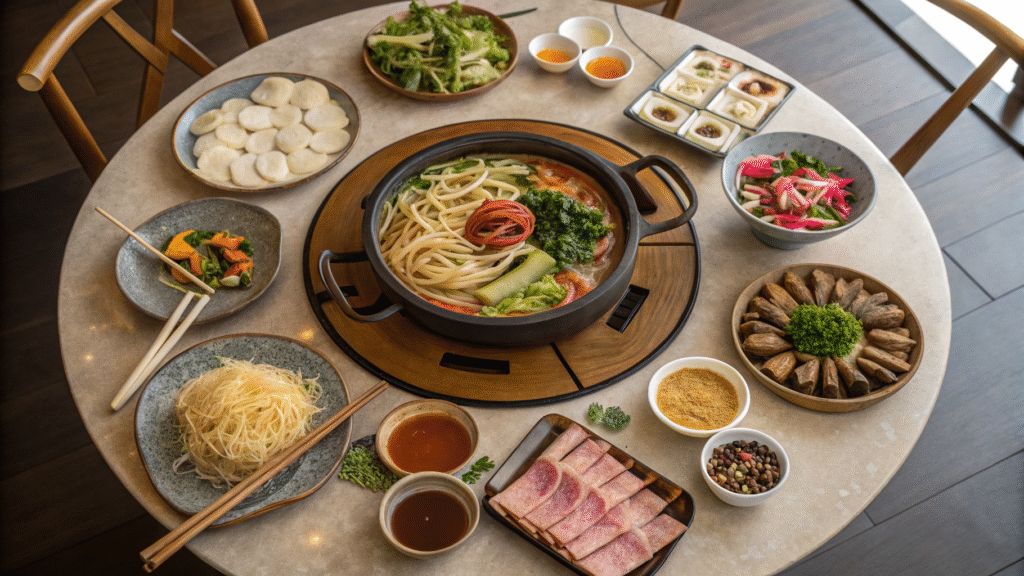
Kunming & Central Yunnan:
- Crossing the Bridge Noodles (过桥米线) – The province’s signature dish: rice noodles served with chicken broth and numerous ingredients added tableside. According to legend, a scholar’s wife created this dish to keep the broth hot as she crossed a bridge to bring him lunch.
- Steam Pot Chicken (汽锅鸡) – Chicken steamed with medicinal herbs in a special pot, resulting in tender meat and flavorful broth.
- Wild Mushroom Hotpot (野生菌火锅) – During summer and autumn, Yunnan’s markets overflow with wild mushrooms used in this exceptional hotpot variant. “yunnan china travel”
- Erkuai (饵块) – Rice cakes that can be fried, grilled, or added to soups. A staple throughout central Yunnan.
Dali & Bai Cuisine:
- Three-Course Tea (三道茶) – A ceremonial tea service reflecting life’s journey: bitter, sweet, and aftertaste.
- Copper Pot Fish (铜锅鱼) – Fresh fish from Erhai Lake cooked tableside in a distinctive copper pot.
- Bai Baba (白粑粑) – Flatbread often stuffed with savory or sweet fillings.
- Crab Apple in Honey (蜂蜜林檎) – A sweet-sour dessert unique to the region.
Lijiang & Naxi Cuisine:
- Lijiang Baba (丽江粑粑) – A Naxi-style savory pancake with meat or vegetable fillings.
- Naxi-style Dried Beef (纳西火腿) – Air-dried spiced beef similar to jerky.
- Fried Cheese (炸乾酪) – A rare dairy product in Chinese cuisine, reflecting Naxi adaptations to mountain living.
- Lijiang Pancake (丽江粑粑) – Thin pancakes filled with brown sugar and rose petals. “yunnan china travel”
Shangri-La & Tibetan Influences:
- Yak Butter Tea (酥油茶) – Traditional Tibetan beverage of tea churned with yak butter and salt.
- Tibetan Momo (藏式饺子) – Dumplings filled with yak meat and served with dipping sauce.
- Tsampa (糌粑) – Roasted barley flour mixed with butter tea, a staple of Tibetan diets.
- Highland Barley Wine (青稞酒) – Alcoholic beverage similar to whisky, traditionally sipped from small cups.
Southern yunnan china travel & Dai Cuisine:
- Ghost Chicken (鬼鸡) – Spicy chicken salad with mint, cilantro, and lime.
- Pineapple Rice (菠萝饭) – Rice cooked inside a hollowed pineapple, absorbing the fruit’s sweetness.
- Bamboo-Tube Rice (竹筒饭) – Glutinous rice stuffed with ingredients and cooked inside bamboo tubes.
- Dai Flavored Fish (傣味鱼) – Fish wrapped in banana leaves with lemongrass and herbs.
Dining Etiquette
- Tea Culture: Tea is served before, during, and after meals. In formal settings, thank the server by tapping two fingers on the table.
- Communal Dining: Food is typically shared family-style with dishes placed in the center.
- Seating Protocol: The guest of honor typically sits facing the entrance.
- Toasting: When drinking alcohol, it’s customary to toast with “Ganbei” (干杯) meaning “dry glass.”
- Chopstick Etiquette: Never stick chopsticks upright in rice (resembles funeral incense) or use them to point at others.
Food Safety Tips
- Street Food: Look for busy stalls with high turnover and visible food preparation.
- Water: Stick to bottled or boiled water, even in higher-end establishments.
- Raw Ingredients: Exercise caution with raw vegetables and fruits that can’t be peeled.
- Allergies: Carry written cards in Chinese explaining food allergies as these are less common and may not be well understood.
Personal Experience: One of my most memorable meals in yunnan china travel was at a small family restaurant in Shaxi, where the grandmother prepared a feast featuring 12 different wild mushroom varieties collected that morning. What made it special wasn’t just the extraordinary flavors but the family’s passion for explaining each dish’s significance in local culture. “yunnan china travel”
Accommodation Guide
yunnan china travel offers diverse accommodation options ranging from international luxury hotels to charming guesthouses and simple homestays. “yunnan china travel”
Types of Accommodation
International Hotels:
- Found primarily in Kunming, Dali, and Lijiang
- Western amenities and English-speaking staff
- Prices: ¥700-2,500+ per night
- Best for: Travelers seeking familiar comforts and services
Boutique Hotels:
- Often in restored traditional buildings
- Combine local character with modern amenities
- Prices: ¥500-1,500 per night “yunnan china travel”
- Best for: Those wanting authentic atmosphere without sacrificing comfort
Guesthouses:
- Family-run establishments common in tourist areas
- Often in traditional buildings with courtyards
- Prices: ¥200-600 per night
- Best for: Independent travelers seeking local insights and moderate comfort
Hostels:
- Available in major destinations
- Dormitory and private room options
- Prices: ¥50-250 per night
- Best for: Budget travelers and solo adventurers
Homestays:
- Stay with local families in their homes
- Most authentic cultural experience
- Prices: ¥100-300 per night (often including meals)
- Best for: Cultural immersion and off-the-beaten-path experiences
Regional Accommodation Notes
Kunming:
- Widest range of international and business hotels
- Green Lake area offers convenient access to attractions
Dali:
- Most atmospheric options are within Dali Old Town
- Lakeshore properties offer peaceful settings
- Xizhou village provides more authentic experiences away from crowds
Lijiang:
- Premium for properties within the Old Town
- Shuhe offers quieter alternatives with similar architecture
- Many guesthouses in renovated Naxi courtyard homes
Tiger Leaping Gorge:
- Simple guesthouses along the hiking trail
- Basic but clean facilities with stunning views
- Advance booking essential during peak season “yunnan china travel”
Shangri-La:
- Limited high-end options
- Traditional Tibetan-style boutique hotels provide unique experience
- Old Town accommodations may have heating issues in winter
Yuanyang:
- Simple guesthouses focused on key viewing areas
- Limited luxury options
- Recommend Duoyishu area for sunrise access
Xishuangbanna: “yunnan china travel”
- Jinghong offers full range from international hotels to guesthouses
- Eco-lodges available in jungle areas
- Traditional Dai houses converted to guesthouses
Booking Tips
- Reservation Timing:
- High Season (July-August, Chinese holidays): Book 1-2 months in advance
- Shoulder Season: 2-3 weeks advance booking recommended
- Low Season: Often possible to book just days ahead
- Booking Platforms:
- Trip.com – Best for comprehensive listings including local establishments
- Booking.com – Good international coverage but fewer local options
- Airbnb – Growing in Yunnan, especially unique properties
- WeChat mini-programs – Popular with domestic travelers but requires Chinese payment methods
- Communication:
- Save your hotel address in Chinese characters for showing taxi drivers
- Confirm whether staff speak English if this is important to you
- Small guesthouses may communicate via WeChat rather than email
- Payment Considerations:
- Many smaller establishments prefer cash or WeChat Pay/Alipay
- International credit cards accepted mainly at larger hotels
- Keep enough cash for smaller places
Practical Information
Visas & Permits
Tourist Visas: “yunnan china travel”
- Most visitors require a visa to enter China
- Apply at Chinese embassies or consulates in your home country
- Standard tourist (L) visas typically allow 30-60 day stays
- Processing time: 4-7 business days standard; expedited service may be available
- Cost varies by country (approximately $140 for US citizens, €125 for EU citizens)
- Some areas offer 144-hour visa-free transit for certain nationalities
Required Documents:
- Valid passport with at least six months validity and blank visa pages
- Completed visa application form
- Recent passport photo
- Proof of accommodation bookings
- Round-trip flight itinerary
- Potential additional requirements depending on nationality
Special Permits:
- Most of yunnan china travel is accessible without special permits
- Exception: Some remote areas along Myanmar and Tibet borders may require additional permissions
- These restrictions can change quickly; check current status before planning visits to border regions
Visa Extensions:
- Possible to extend tourist visas once while in China
- Apply at local Public Security Bureau (PSB) offices in larger cities
- Typically granted for 30 additional days “yunnan china travel”
- Required documents: passport, visa extension form, passport photos, proof of sufficient funds
Official Resources:
Money & Budgeting
Currency:
- Chinese Yuan (CNY/¥), also called Renminbi (RMB)
- Notes: ¥1, ¥5, ¥10, ¥20, ¥50, ¥100
- Coins: ¥0.1, ¥0.5, ¥1 (coins increasingly uncommon)
Cash vs. Digital Payments:
- Major shift toward mobile payments in recent years
- WeChat Pay and Alipay dominate domestic transactions
- International visitors can now link foreign credit cards to WeChat Pay (though functionality may be limited)
- Cash still necessary for rural areas, small vendors, and as backup “yunnan china travel”
ATMs & Currency Exchange:
- ATMs widely available in cities and major tourist areas
- Banks like ICBC, Bank of China, and China Construction Bank reliable for foreign cards
- Daily withdrawal limits typically ¥2,000-¥3,000
- Exchange currency at banks rather than hotels for better rates
- Keep exchange receipts if planning to convert yuan back to foreign currency
Sample Budgets (per person per day):
Budget Traveler: ¥200-400 (US$30-60)
- Hostel dorm: ¥50-100
- Street food and simple restaurants: ¥50-100
- Public transportation: ¥20-50
- Attractions: ¥50-100
- Occasional splurge: ¥50
Mid-range Traveler: ¥500-1,000 (US$75-150)
- Budget hotel or private guesthouse room: ¥200-400
- Sit-down restaurants: ¥150-250
- Mix of public and private transportation: ¥50-150
- Attractions and activities: ¥100-200
Luxury Traveler: ¥1,500+ (US$225+)
- Boutique or international hotel: ¥800-2,000+
- Fine dining: ¥300-500+
- Private drivers and guides: ¥500-1,000
- Premium experiences: ¥500+
Tipping Culture:
- Not traditionally expected in China
- High-end establishments may add 10-15% service charge
- International hotels may expect tips from international travelers
- Private guides and drivers typically appreciate ¥50-100 per day
Safety & Health
General Safety:
- yunnan china travel is generally very safe for travelers
- Violent crime against foreigners extremely rare
- Main concerns are petty theft in crowded tourist areas
Common Scams:
- Tea house scams: Friendly locals invite you to traditional tea ceremony with unexpected high bill
- Unofficial guides: Unregistered guides offering services at popular sites
- Taxi overcharging: Insist on meter or agree on price before departure
- Counterfeit currency: Examine larger bills carefully, especially from non-bank sources
Health Considerations:
- Altitude Sickness: Real concern in northern Yunnan (Shangri-La, Deqin)
- Ascend gradually if possible
- Consider preventative medication like Diamox (consulta doctor)
- Stay hydrated and avoid alcohol first few days
- Symptoms include headache, nausea, fatigue, and shortness of breath
- Food Safety:
- Stick to busy restaurants with high turnover
- Ensure meat is thoroughly cooked
- Be cautious with street food in very hot weather
- Water:
- Drink only bottled, boiled, or properly filtered water
- Avoid ice in smaller establishments
- Remember this when brushing teeth
- Vaccinations:
- Routine vaccinations should be up to date
- Hepatitis A and Typhoid recommended
- Consider Japanese Encephalitis if visiting rural areas during summer months
- Consult travel health professional before departure
Medical Facilities:
- Best medical facilities in Kunming
- International-standard hospitals:
- yunnan china travel Provincial Hospital
- Kunming Medical University First Affiliated Hospital
- Tourist areas have basic clinics for minor issues
- Consider travel health insurance with evacuation coverage
Emergency Numbers:
- Police: 110
- Ambulance: 120
- Fire: 119
Solo Female Travel:
- Generally safe throughout Yunnan
- Standard precautions apply (avoid isolated areas at night)
- Conservative dress recommended in rural minority areas
- Female-only dorms available in most hostels
Language & Communication
Language Landscape:
- Mandarin Chinese is the official language
- Local dialects and minority languages widely spoken
- English proficiency limited outside major tourist areas and upscale establishments
- Young people more likely to speak some English
Essential Phrases:
- Hello: Nǐ hǎo (你好)
- Thank you: Xièxiè (谢谢)
- How much?: Duōshǎo qián? (多少钱?)
- Too expensive: Tài guì le (太贵了)
- Delicious: Hěn hǎo chī (很好吃)
- Bathroom: Cèsuǒ (厕所)
- I don’t understand: Wǒ bù dǒng (我不懂)
- Help: Bāng máng (帮忙)
Communication Tools:
- Translation Apps:
- Pleco (Chinese dictionary with camera translation)
- Google Translate (download offline Chinese package)
- Baidu Translate (works well within China)
- Communication Cards: Print key phrases and destinations in Chinese
- WeChat: Essential for contacting guesthouses and local services
Internet Access:
- Internet censorship (“Great Firewall”) blocks many Western sites and apps
- Affected services include: Google, Facebook, Instagram, Twitter, WhatsApp, YouTube
- VPN (Virtual Private Network) required to access these services
- Download and set up VPN before arriving in China
- Reliability varies; having multiple options recommended
- Public WiFi available in most accommodations, cafes, and restaurants
- Local SIM cards with data packages affordable and recommended
Mobile Service:
- China Mobile, China Unicom, and China Telecom offer tourist SIM cards
- Available at airports, major transportation hubs, and mobile shops
- Requirements for purchase: passport and registration
- Cost: Approximately ¥100-200 for 30 days with generous data allowance
- Registration process stricter than in past years; official shops simplify this
Packing List
Clothing (adjust for season):
- Layerable clothing for variable temperatures
- Thermal underlayers (October-April, especially for northern Yunnan)
- Rain jacket/poncho (year-round)
- Sun hat and sunglasses
- Comfortable walking shoes/hiking boots
- Quick-dry clothing (especially during rainy season)
- Conservative clothing for temple visits (shoulders and knees covered)
- Evening layer (even summer nights can be cool at higher elevations)
Health & Toiletries:
- Personal medications in original packaging with prescription
- Altitude sickness medication if visiting high-elevation areas
- Sunscreen (harder to find locally)
- Hand sanitizer and wet wipes
- Tissues/toilet paper (not always provided in public restrooms)
- Travel first aid kit
- Insect repellent (especially for southern Yunnan)
- Diarrhea medication
Technology:
- Unlocked smartphone
- Camera with extra storage
- Power bank
- Universal power adapter (China uses 220V, mostly Type A or C plugs)
- VPN service installed before arrival
- Offline maps downloaded
Documentation: “yunnan china travel”
- Passport and visa (plus copies/digital backups)
- Travel insurance details
- Hotel reservations (printed in Chinese if possible)
- Emergency contact information
- Cash and credit cards
Seasonal Considerations: “yunnan china travel”
- Summer (June-August): Lightweight clothing, rain gear, insect repellent
- Fall (September-November): Light layers, light jacket, warmer layers for north
- Winter (December-February): Warm clothing for central/north Yunnan, lighter layers for south
- Spring (March-May): Versatile clothing for changeable weather
Responsible Travel in Yunnan
Cultural Sensitivity
- Photography Etiquette:
- Always ask permission before photographing people
- Respect refusals without argument
- Consider offering to share photos via WeChat
- Avoid photography during religious ceremonies without explicit permission
- Some minorities believe photography captures the soul—be particularly sensitive
- Religious Sites:
- Observe appropriate dress codes (cover shoulders, knees)
- Remove hats when entering temples
- Walk clockwise around Buddhist structures (stupas, prayer wheels)
- Speak softly and avoid pointing at religious figures
- Ask before photographing religious artifacts or ceremonies
- Interaction with Minorities:
- Learn basic greetings in local languages if possible
- Understand that some customs may differ from Han Chinese traditions
- Be aware that some “traditional villages” may feel staged for tourism
- Support authentic cultural experiences over commercialized displays
- Remember that ethnic minorities are modern people, not museum exhibits
Environmental Responsibility
- Waste Management:
- Carry reusable water bottle with filter or purification method
- Pack out all trash from hiking areas
- Avoid single-use plastics where possible
- Dispose of waste properly, especially in remote areas with limited facilities
- Natural Resource Conservation:
- Stay on marked trails when hiking
- Respect wildlife by maintaining distance and not feeding animals
- Choose environmentally responsible tour operators
- Consider carbon offsetting for flights to/from the region
- Sustainable Choices:
- Select locally-owned accommodations over international chains
- Eat at locally-owned restaurants serving regional specialties
- Purchase directly from artisans rather than large souvenir shops
- Choose tours that give back to local communities
Economic Impact
- Fair Compensation:
- Avoid aggressive bargaining for goods and services
- Pay fair prices that reflect quality and effort
- Tip guides and service staff appropriately
- Be willing to pay entrance fees that support conservation and cultural preservation
- Authentic Souvenirs:
- Purchase genuine handicrafts directly from artisans
- Avoid items made from endangered species or antiquities
- Look for workshops where you can see items being made
- Quality products that support traditional crafts may cost more but have greater value
FAQ Section
Do I need a visa to visit Yunnan, China?
Yes, most foreigners require a tourist visa to enter China. Apply at Chinese embassies or consulates in your home country, typically 1-2 months before travel. Some countries qualify for 72-hour or 144-hour visa-free transit under specific conditions.
Is it safe to travel in Yunnan?
Yunnan is generally very safe for tourists. Violent crime is rare, though petty theft can occur in crowded tourist areas. The main health concerns are altitude sickness in northern regions and standard travel precautions regarding food and water safety.
When is the best time to visit Yunnan?
Spring (March-May) and autumn (September-November) generally offer the most pleasant weather across the province. However, optimal timing depends on specific regions: winter (December-February) is ideal for southern tropical areas, while summer (June-August) works well for northern high-altitude regions despite some rainfall.
How much time should I spend in Yunnan?
A minimum of 7-10 days is recommended to experience the highlights (Kunming, Dali, Lijiang). Two weeks allows for a more comprehensive experience including Shangri-La and Tiger Leaping Gorge. Three weeks would enable exploration of more off-the-beaten-path areas like Yuanyang Rice Terraces or Xishuangbanna.
How do I deal with the language barrier?
English proficiency is limited outside major tourist areas. Download translation apps like Pleco or Google Translate with offline Chinese capability. Carry a card with your hotel address in Chinese characters. Learn basic phrases, use gestures, and be patient. In tourist areas, younger people often speak some English.
Can I use credit cards and ATMs in Yunnan?
International credit cards are accepted at upscale hotels, restaurants, and larger stores in cities, but cash dominates elsewhere. ATMs accepting foreign cards are readily available in cities and tourist towns. China increasingly uses mobile payment systems (WeChat Pay, Alipay) which can be challenging for foreigners to access, so carry sufficient cash for smaller establishments.
Do I need special permits to visit certain areas?
Most of Yunnan is accessible without special permits. Some remote areas near the Myanmar and Tibet borders occasionally require additional permissions, but these restrictions change frequently. Check current requirements if planning to visit border regions.
How do I manage internet access and stay connected?
China’s “Great Firewall” blocks many Western websites and apps including Google, Facebook, and WhatsApp. Install a reliable VPN before arriving in China to access these services. Purchase a local SIM card (bring your passport) for affordable data access, available at airports and mobile shops in cities.
Is altitude sickness a concern in Yunnan?
Yes, in northern Yunnan. Shangri-La sits at 3,200m elevation, while other attractions can exceed 4,000m. Symptoms include headaches, dizziness, and fatigue. Ascend gradually, stay hydrated, avoid alcohol initially, and consider preventative medication. Consult a doctor before traveling if you have heart or lung conditions. “yunnan china travel”
What electrical adapters do I need?
China uses 220V, 50Hz electricity with primarily Type A (two-prong flat) and Type I (three-prong V-shaped) outlets. Bring a universal adapter. Most modern electronics handle dual voltage, but check your devices to be certain.
How much should I budget for traveling in Yunnan?
Budget travelers can manage on ¥200-400 ($30-60) per day staying in hostels and eating at local establishments. Mid-range travelers should budget ¥500-1,000 ($75-150) daily for comfortable guesthouses and restaurants. Luxury travelers will spend ¥1,500+ ($225+) daily for boutique hotels, private transportation, and fine dining. “yunnan china travel”
Is the food safe to eat in Yunnan?
Budget travelers can manage on ¥200-400 ($30-60) per day staying in hostels and eating at local establishments. Mid-range travelers should budget ¥500-1,000 ($75-150) daily for comfortable guesthouses and restaurants. Luxury travelers will spend ¥1,500+ ($225+) daily for boutique hotels, private transportation, and fine dining.
What should I pack for a trip to Yunnan?
Layered clothing regardless of season due to variable temperatures, comfortable walking shoes, rain jacket, sun protection, basic medications including any for altitude sickness, universal power adapter, and VPN software installed before arrival. If visiting in winter, bring proper cold-weather gear for northern regions.
Author’s Experience
I first visited Yunnan in 2015 and have returned four times since, most recently spending six weeks exploring the province from south to north in late 2024. Each visit reveals new dimensions of this endlessly fascinating region. “yunnan china travel”
On my latest trip, I discovered that spending extra time in less-visited locations yielded the most rewarding experiences. While the major destinations certainly deserve their reputation, I found particular joy in:
- Dawn photography at Yuanyang Rice Terraces: Arriving a day before most tour groups and staying in a small guesthouse in Duoyishu village allowed me to reach the prime viewpoint at 5:30 AM, well before the crowds arrived at 6:30. The absolute silence as light gradually revealed the intricate terraces was worth the early wake-up. “yunnan china travel”
- Cycling the eastern shore of Erhai Lake: While most visitors stick to the western shore, I rented an e-bike in Dali and discovered nearly empty roads leading to authentic fishing villages on the eastern side. In Wase village, a local family invited me to join their lunch of freshly caught fish prepared with local herbs I’d never encountered before.
- Seeking out master craftspeople: In Xizhou near Dali, I spent an afternoon with Mr. Yang, a third-generation tie-dye master who uses traditional Bai techniques and natural indigo dye. The workshop wasn’t on any tourist map—my guesthouse owner made the introduction. The half-day I spent learning basic techniques resulted in a scarf with far more personal value than any souvenir I could have purchased.
- Lingering in Shaxi: Most travelers visit this ancient tea horse road town as a day trip or single overnight between Dali and Lijiang. By staying three nights, I developed a rhythm with the town, finding hidden courtyards, attending the vibrant Friday market, and hiking to the Shibaoshan grottoes without tour crowds. “yunnan china travel”
The essence of Yunnan isn’t found in rushing between highlights but in slowing down enough to engage with its people, landscapes, and traditions. I encourage you to build “unscheduled time” into your itinerary—these often become the most memorable parts of your journey.
This guide aims to provide comprehensive information while avoiding the generic advice found in many travel resources. I’ve focused on practical details, authentic experiences, and insights that have made my own yunnan china travel journeys more rewarding.
If you have specific questions about planning your yunnan china travel adventure that aren’t addressed here, feel free to reach out in the comments section below, and I’ll do my best to help!
Note: All information was current as of May 2025. Always check for updated visa requirements, transportation schedules, and regional access restrictions before traveling.

